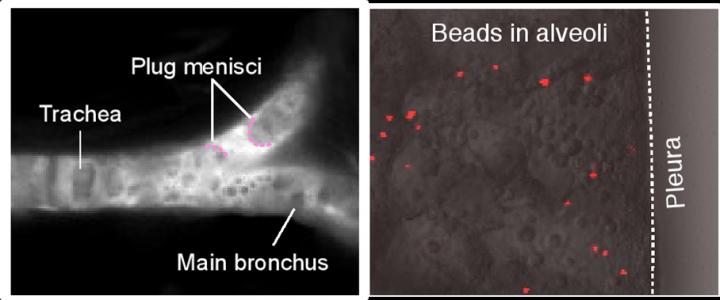Columbia Engineering team develops targeted drug delivery to lung

A small liquid plug in the bronchus is manipulated by air ventilation to deliver drug into the most distant alveoli. Credit: Jinho Kim//Columbia Engineering
Researchers from Columbia Engineering and Columbia University Medical Center (CUMC) have developed a new method that can target delivery of very small volumes of drugs into the lung.
Their approach, in which micro-liters of liquid containing a drug are instilled into the lung, distributed as a thin film in the predetermined region of the lung airway, and absorbed locally, may provide much more effective treatment of lung disease. The work was published in the August 31 online Early Edition of Proceedings of the National Academy of Sciences (PNAS).
Lungs are susceptible to many diseases, including cystic fibrosis, bronchopneumonia, chronic obstructive pulmonary disease, and lung cancer, that are currently treated by systemic application of drugs, by oral intake, or aerosol inhalation.
In order to achieve therapeutic levels at the pathological site, physicians need to deliver large amounts of the drug that may cause adverse effects to other organs in the body. Lung diseases could be more effectively treated if the drug of choice could be delivered locally to the pathologic site in the lung, at the exact dose needed for the treatment.
“We envision that our micro-volume liquid instillation approach will enable predictable drug concentrations at the target site, reducing the amount of drug required for effective disease treatment with significantly reduced side effects,” says Gordana Vunjak-Novakovic, Mikati Foundation Professor of Biomedical Engineering and professor of medical sciences (in Medicine), who supervised the work in her Laboratory for Stem Cells and Tissue Engineering.
The main challenge for the team was the enormous complexity of the lung structure that provides the vital function of oxygen and carbon dioxide exchange with the blood. Both the tissue architecture and the air flow change dramatically along the 24 generations of the lung airway, from the large bronchus down to the alveoli.
Jinho Kim, a postdoctoral fellow in Vunjak-Novakovic's lab and the lead author of the study, realized that the distance a liquid plug travels before being absorbed as liquid film can be varied by changing the plug volume and the regime of ventilation.
By studying liquid plugs in simple glass tubes, he developed a mathematical model describing liquid transport process in each generation of the airway tree. The model was used to determine the liquid plug volume and the parameters of programmed ventilation for delivery into a specific region of the lung. The model predictions were confirmed by demonstrating targeted liquid film deposition in ventilated lungs, using three different imaging modalities.
“Liquid instillation has been used for providing lung surfactant to the entire lungs in premature infants that cannot produce enough surfactant to breathe normally,” Kim observes. “Although liquid instillation has great therapeutic potential, its applications have been unexplored, largely because of limited understanding of the liquid transport in the lung airways. We are very excited about the implications of our work.”
The project has been a highly collaborative one, says Vunjak-Novakovic, whose team included three biomedical engineers, a lung transplant surgeon, and a pulmonologist: “This study is truly emblematic of how biomedical research is conducted at Columbia University.”
Kim devised the approach for targeted delivery of micro-volumes of drugs, developed the necessary theory, and conducted the supporting experiments with John O'Neill, a biomedical engineering PhD student. At CUMC, Matt Bacchetta, associate professor of surgery, and Valerio Dorrello, assistant professor of pediatrics, helped define the clinically relevant parameters for drug delivery, and optimize lung ventilation and perfusion. The researchers plan next to demonstrate treatment of lung diseases such as cystic fibrosis and airway infections by delivering pulmonary drugs using their liquid instillation approach.
“We are fascinated by the opportunities that bioengineering approaches offer to more effectively treat lung disease,” Vunjak-Novakovic adds. “The lung is a hugely complex organ that has billions of cells within a hierarchically organized tissue that cannot be built from scratch. Four years ago, we started research of lung regeneration using stem cells and bioengineering methods. And we continue to work with our clinical colleagues to develop new treatment approaches for treating lung disease.”
###
This research has been supported by the National Institutes of Health (experimental and modeling studies), the Raymond and Beverly Sackler Foundation (pilot grant for Jinho Kim) and the Mikati Family Fund for Translational Research in Biomedical Engineering (development of a new system for lung ventilation and perfusion).
LINKS
Paper — http://www.
Vunjak-Novakovic — http://bme.
Laboratory for Stem Cells and Tissue Engineering — http://orion.
Columbia Engineering — http://engineering.
CUMC — http://www.
Media Contact
All latest news from the category: Health and Medicine
This subject area encompasses research and studies in the field of human medicine.
Among the wide-ranging list of topics covered here are anesthesiology, anatomy, surgery, human genetics, hygiene and environmental medicine, internal medicine, neurology, pharmacology, physiology, urology and dental medicine.
Newest articles

Combatting disruptive ‘noise’ in quantum communication
In a significant milestone for quantum communication technology, an experiment has demonstrated how networks can be leveraged to combat disruptive ‘noise’ in quantum communications. The international effort led by researchers…

Stretchable quantum dot display
Intrinsically stretchable quantum dot-based light-emitting diodes achieved record-breaking performance. A team of South Korean scientists led by Professor KIM Dae-Hyeong of the Center for Nanoparticle Research within the Institute for…

Internet can achieve quantum speed with light saved as sound
Researchers at the University of Copenhagen’s Niels Bohr Institute have developed a new way to create quantum memory: A small drum can store data sent with light in its sonic…





















